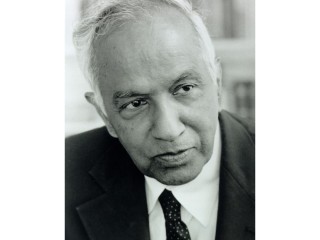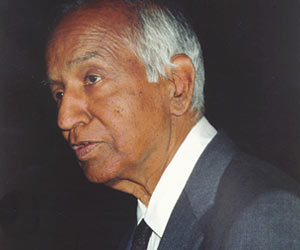
Subrahmanyan Chandrasekhar was born on October 19, 1910 in Lahore. His father, Chandrasekhara Subrahmanya Ayyar was an officer in Government Service in the Indian Audits and Accounts Department. His mother Sita was a woman of high intellectual attainments. C.V. Raman, the first Indian to get Nobel Prize in science was the younger brother of Chandrasekhar's father. Till the age of 12, Subramanyan Chandrasekhar had his education at home under his parents and private tutors. In 1922, at the age of 12, he attended the Hindu High School. He joined the Madras Presidency College in 1925. Subrahmanyan Chandrashekhar passed his Bachelor's degree, B.Sc. (Hon.), in physics in June 1930. In July 1930, he was awarded a Government of India scholarship for graduate studies in Cambridge, England.
His early education, till he was twelve, was at home by his parents and by private tuition. In 1918, his father was transferred to Madras where the family was permanently established at that time.
In Madras, he attended the Hindu High School, Triplicane, during the years 1922 - 25. His university education (1925 - 30) was at the Presidency College. He took his bachelor's degree, B. Sc. (Hon.), in physics in June 1930. In July of that year, he was awarded a Government of India scholarship for graduate studies in Cambridge, England. In Cambridge, he became a research student under the supervision of Professor R. H. Fowler (who was also responsible for my admission to Trinity College). On the advice of Professor P. A. M. Dirac, he spent the third of my three undergraduate years at the Institut för Teoretisk Fysik in Copenhagen.
He took his Ph.D. degree at Cambridge in the summer of 1933. In the following October, he was elected to a Prize Fellowship at Trinity College for the period 1933 - 37. During his Fellowship years at Trinity, he formed lasting friendships with several, including Sir Arthur Eddington and Professor E. A. Milne.
While on a short visit to Harvard University (in Cambridge, Massachusetts), at the invitation of the then Director, Dr. Harlow Shapley, during the winter months (January-March) of 1936, he was offered a position as a Research Associate at the University of Chicago by Dr. Otto Struve and President Robert Maynard Hutchins. He joined the faculty of theUniversity of Chicago in January 1937. And he have remained at this University ever since.
During his last two years (1928 - 30) at the Presidency College in Madras, he formed a friendship with Lalitha Doraiswamy, one year his junior. This friendship matured; and they were married (in India) in September 1936 prior to his joining the University of Chicago. In the sharing of their lives during the past forty-seven years, Lalitha's patient understanding, support, and encouragement have been the central facts of his life.
After the early preparatory years, his scientific work has followed a certain pattern motivated, principally, by a quest after perspectives. In practise, this quest has consisted in his choosing (after some trials and tribulations) a certain area which appears amenable to cultivation and compatible with my taste, abilities, and temperament. And when after some years of study, he feel that he have accumulated a sufficient body of knowledge and achieved a view of his own, he have the urge to present his point of view, ab initio, in a coherent account with order, form, and structure.
There have been seven such periods in his life: stellar structure, including the theory of white dwarfs (1929 - 1939); stellar dynamics, including the theory of Brownian motion (1938 - 1943); the theory of radiative transfer, including the theory of stellar atmospheres and the quantum theory of the negative ion of hydrogen and the theory of planetary atmospheres, including the theory of the illumination and the polarization of the sunlit sky (1943 - 1950); hydrodynamic and hydromagnetic stability, including the theory of the Rayleigh-Bernard convection (1952 - 1961); the equilibrium and the stability of ellipsoidal figures of equilibrium, partly in collaboration with Norman R. Lebovitz (1961 - 1968); the general theory of relativity and relativistic astrophysics (1962 - 1971); and the mathematical theory of black holes (1974 - 1983).
Dr Chandrasekhar died in 1995.
Subrahmanyan Chandrasekhar was one of the greatest scientists of the 20th century. He did commendable work in astrophysics, physics and applied mathematics. Chandrasekhar was awarded the Nobel Prize in Physics in 1983.




No comments:
Post a Comment